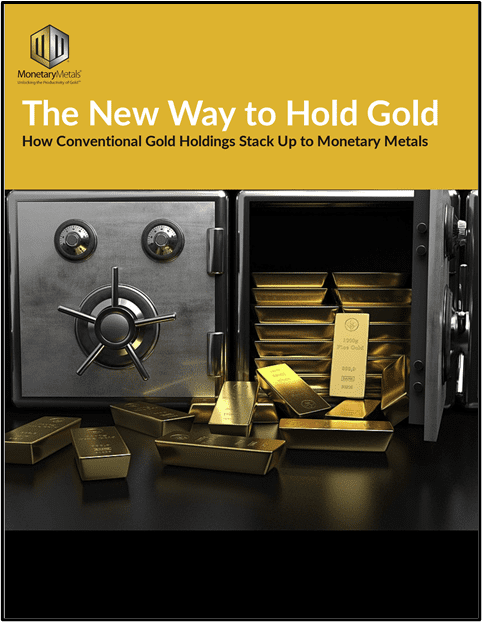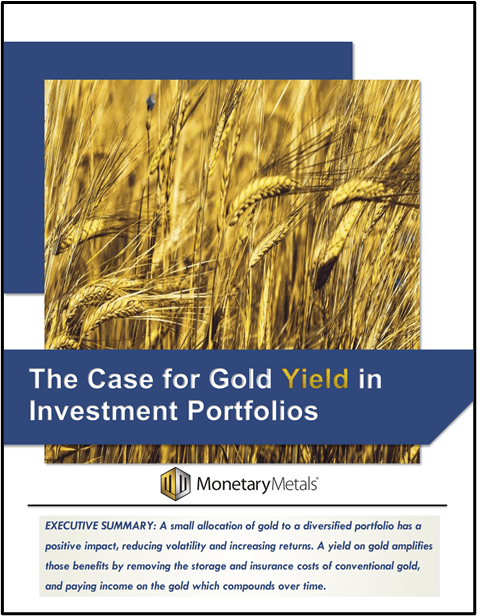Transcript
Adrian Day shares his insights on the economy’s resilience, the role of central banks, and the importance of considering investment opportunities beyond the US.
Additional Resources
Earn a yield on gold, paid in gold
The Case for Gold Yield in Investment Portfolios
Podcast Chapters
[00:00:00]: Adrian Day
[00:00:28]: Backstory
[00:01:13]: Impact of Interest Rates
[00:03:03]: Corporate Debt
[00:04:25]: Future Interest Rates
[00:05:15]: Performance of Gold
[00:07:03]: Global Investment Opportunities
[00:09:33]: Risk and Reward
[00:11:23]: Central Bank Policies
[00:14:13]: Recommended Readings
[00:17:48]: Earn a yield on gold, paid in gold
Transcript:
Ben Nadelstein:
Welcome back to The Gold Exchange Podcast. My name is Ben Nadelstein. I’m joined today by Adrian Day. Adrian, how are you doing?
Adrian Day:
Doing fine, thank you. How are you? Great, Adrian.
Ben Nadelstein:
Tell us a little bit about who you are in case someone on the planet doesn’t know you.
Adrian Day:
I was going to say, who am I talking to here? No, I’m joking. Well, Adrian Day, I have my own money management firm. We’ve been doing it for 40 years and we invest in both global markets and resources. Then I also manage Peter Schiffs, the CEO of the Pacific Gold Fund.
Ben Nadelstein:
Adrian, at 5 % interest rates, many commentators have said it would be like a nuclear bomb on stock markets. It would be a financial explosion like the world’s never seen. And yet, things seem to be okay. What is your analysis
Adrian Day:
Yeah, I think, first of all, step back. Investors generally, we always expect things to happen in a much more dramatic fashion and much sooner. But in fact, they do happen. Five, five and a half in fact, five and a half % interest rates in fact will have an effect on the economy. But it’s not surprising to me that it hasn’t happened yet. I think there’s a lot of resilience in the economy. When you think that we had ultra-excessive monetary policy and excessively low interest rates for so long, basically for 12 or 11 years before, 12 years before they started hiking, that gave households and corporations all the opportunity in the world to refinance, to refinance at lower rates, but also to term out their debt for longer. It’s not surprising that rates have gone from zero, lower bound to five and a half, and it hasn’t had such a dramatic effect on the economy yet because for the most part, people have strong balance. Households had strong balances, corporations certainly had strong balances, and people have termed out the debt. So the company, the corporation, for example, who let’s say three years ago, refinanced all their debt, paid off all their existing debt, and then got new five-year loans at 3%, they haven’t been affected yet.
They haven’t been affected. So the higher for longer mantra of Powell to me is much more significant than whether they do another hike or not.
Ben Nadelstein:
Let’s see if I can summarize. There’s balance sheets that are actually doing quite well because of this lower interest rate policy. They could refinance, they could shore up their balance sheets, and the debt is a little bit longer term duration. A 5% nominal print, that’s probably not going to do much. Now, higher for longer, that’s a.
Adrian Day:
Different discussion. Exactly. If you look at the absolute number of corporate maturities this year, next year, and then 25, you see that 25 is more than double what it is this year. I can’t remember the absolute numbers. I’m sorry. I think it’s 600 billion. But I don’t want to say in case it’s wrong, but I just said it. But the point is next year, the number of death maturities of corporations goes up by about 50%, and then the year after that, it’s up another 50%. Those are the two important years.
Ben Nadelstein:
Do you see a scenario where we’re at five or five and a half % interest rates in two years from now? No.
Adrian Day:
No, because something will have broken by then. I mean, we already had the banking crisis earlier, of course, but I think if we keep rates at five and a half % for very much longer, as the economy starts to move into a recession, that’s going to cause more damage. I don’t think they can keep rates here for two years now.
Ben Nadelstein:
Now let’s talk about some assets here. Let’s start with gold. Gold has held up surprisingly well. Many analysts had said five and a half interest rates would be a headwind against gold. They said that gold would actually falter because most people would say, Why would I buy a shiny pet rock when I could earn five and a half % on a T-bill or a money market? Are you surprised at how well gold is held up? Or are you certain that this is part of your analysis?
Adrian Day:
No. I mean, you make really interesting points. One thing I’ll say is that, again, it gets back to what I said earlier, gold investors in particular, they’re always disappointed by gold. They always expect more from gold. But a year ago, we were just a little over 1,600. So to go from 1,600 to whatever it is.
Ben Nadelstein:
Almost.
Adrian Day:
It changes every day, but to 1950, 2,000 in a year in the face of 5% interest rates, in the face of not just interest rates, but monetary tightening generally is astonishing, frankly. It’s very good performance, and we know why. It’s all, never say all, but it’s primarily due to central bank buying. Because ETFs, of course, we see the numbers, ETFs have had massive outflows. Apart from a couple of months earlier this year, February, March, it’s been for 12 months, it’s been net outflows and accelerating net outflows from the ETFs. That’s not where the support is coming from. I was just talking to a dealer. I don’t know what your experience has been, but he said that they’re certainly not getting a wave of the United States, yes. -in the United States. You can tell that the evidence is less firm and more anecdotal, but you can tell that in the premiums, the premiums have come down. It’s not the retail person who’s supporting gold. Who’s supporting gold? I think, is primarily the central banks and then it’s also the very wealthy individuals and institutions in Europe, but mostly in the Middle East and Asia, who are buying physical.
Ben Nadelstein:
Let’s talk about the rest of the world. We have a very US centric focused investors and a lot of monetary policy focuses on the Fed and the United States. But let’s talk about the rest of the world for a little bit. There are some analysts who say the US has the strongest economy. There’s really no point in looking anywhere else. If you’re looking at the rest of the world, you’re essentially just burning your dollars to the bring them down a pit you’ll never see ever again.
Do you see how that analysis makes sense and the US economy is important? Or should we be looking elsewhere as well?
Adrian Day:
Of course, it doesn’t make sense. The US, it varies, but it’s 50% of the global economy and it’s 50% of global stock markets. But if you ignore the rest of the world, you’re ignoring half of the opportunities out there. If you think the US is and has been the strongest economy for a long period of time, then by its nature, if you avoid the rest of the world, you’re avoiding some of the best opportunities that are out there. Maybe more risky opportunities, but best. I mean, I remember Warren Buffett, who’s a… I have a love-hate relationship with Warren Buffett. As do I. Yeah. He does say some wonderful things, although that farmer wisdom gets a little bit… That shtick gets a little bit old after a while. But I mean, there’s no gain saying he’s done very well. But my point is when he says, Oh, just look at the US, which he’s ignored his own advice recently, of course. But I say to people, Well, in that case, why don’t I just look at investment opportunities in Puerto Rico? Because I know those better than I know California. Let’s just stick to our home state.
The logic is exactly the same. Let’s forget Puerto Rico for a second. But if you’re in California, you could argue there’s plenty of opportunities in California. That’s a great point. It’s a nonsensical argument. I think it’s a mistake. And of course, we all know, if we study history, we all know that even though the US has been dominant since the Second World War, there have been long periods when foreign markets have outperformed the US dramatically over a period of years. Think of John Templeton, who in my mind is the greatest investor ever. His Templeton fund could move anywhere they wanted, but he oncehe once was as high as 90% in Japan, and that was for multiple years. My point being is that there’s good opportunities everywhere. Sometimes the US is the best place to invest, sometimes it’s not.
Ben Nadelstein:
I do like that point because if we’re just simply going on what we know best or what feels closest to home, you should invest in your hometown. I mean, you should be looking around in eyesight. But clearly there’s other opportunities. Like you’re mentioning, the difference between safety and return is a spectrum.
Adrian Day:
Right, of course. It’s a matter of risk reward, isn’t it? It’s a matter of risk reward. Now, there are some people at a certain age or whatever, there are some people who simply cannot take, let’s say, X amount of risk, regardless of the reward potential. They simply can’t justify that. But for most investors, it really is a balance. What’s the risk? What’s the reward? This risk, albeit higher risk, but potential is so much greater that this one is a better risk reward.
Ben Nadelstein:
Now, I have a question. We’ve talked a little bit about gold. We’ve talked a bit about foreign currencies, and we’ve talked a bit about central banks buying gold. Do you see that other central banks are doing something different than the US is doing? Should we be looking at, for example, Japan and Yield Curve control, the Chinese and the Taiwan?
Adrian Day:
Oh my gosh, please not. Well, there’s certainly some central banks that are doing better than others. I’ll I can’t quote him, but I’ll paraphrase the presidential nominee in Argentina. Milei? Milei, yes. I don’t know his first name.
Ben Nadelstein:
Javier.
Adrian Day:
Javier, thank you. Javier Milei. He says that all central banks are bad. The Federal Reserve is really bad and the Argentine Central Bank is plain evil. I would say that all central banks are bad in the sense that I think the whole theory of a central bank is wrong, is in error. But within the construct of having central banks, there are certainly some that are doing a far better job. Singapore would be one. I wouldn’t point Japan up as an example. You were joking, of course. Absolutely. Thank you. Well, I was about to take the mic off and walk off.
Ben Nadelstein:
I was about to have this very tight around my neck.
Adrian Day:
Unfortunately, Swiss National Bank used to be an extraordinary, solid central bank, hasn’t been for 10 years. They’ve turned into a hedge fund, basically. But some bank of England is useless. They have been for 10 years. I always thought growing up, I always thought they were an institution to look up to. Maybe I was naive at the time.
Ben Nadelstein:
Now, question for you. There seems to be a lot of dead ends here. We’ve talked about, well, this currency or this country might not be the next place to invest. What are some underappreciated investments or different areas to invest?
Adrian Day:
Gosh, that’s a good example. Well, good question. I do think that the best risk reward is the gold stocks. That’s not exactly under-recognized. Typically, my macro view is we’re moving into a stagflation. I think we’re going to move into a recession or sluggish economy before the Fed has quashed and other central banks have quashed inflation. We’re going to have a stagflation. In a stagflation, one of the top performing assets are emerging market stocks and bonds. Really, it’s smaller markets, not just emerging markets, but smaller market. The problem is they tend to do well when the dollar is falling. At the moment, we’re moving into a stagflationary period when they should be doing well, but the dollar has been very strong. That’s on balance, that’s negative for smaller markets because so many in the smaller markets are… I think it’s so many corporations will take US dollar debt out because to borrow money in the local, in the BAT or whatever, is just too expensive. Of course, they’re getting crushed as the dollar goes up. If you start to see, sorry, just to finish your thought, if we start to see the dollar go down, if I’m just saying if we start to see the dollar go down, then I think we should start to look at some smaller markets in a broad sense.
Adrian Day:
But without that, I’m being very selective, very bottom-up, frankly, very idiosyncratic. We have investments in Singapore, we have investments in Malaysia, we have investments in Argentina. That’s a shorter term speculation. But I don’t have much in the major markets of at the moment.
Ben Nadelstein:
Now, one of our final questions here, who are you reading? What do you follow? What are some books or analyzes that you like to read to really keep yourself informed and that have influenced your analysis?
Adrian Day:
Oh, gosh. Well, in terms of books, I’ll come to that one first. I think the Money Masters book was a classic. I’ve forgotten who wrote it, John someone. But people can look it up in Amazon. There’s multiple of it. I think the first one is the best. Money Masters simply looks at some of the most successful money managers and what their style is. And the beauty of that book is it shows you, it demonstrates clearly that there’s more than, or I mustn’t say more than one way to skin a carrot because my daughter doesn’t like me saying that. There’s- One.
Ben Nadelstein:
Way, more than one way to skin a carrot.
Adrian Day:
Peel a carrot. There’s more than one way to peel a carrot. Because you see all these successful investors and each one has a different approach. The lesson that I got from that book, frankly, is don’t try to be all things and do all things. I don’t mean, be stubborn, but if you’re a value investor and you’re buying undervalued assets that you spent a lot of time researching and you know this is a good asset that’s undervalued, well, don’t suddenly become a trend follower when it drops 5%. Because if you’re a value investor, a 5 % drop is meaningless. Similarly, if you’re a momentum investor and the things for momentum stops going in the wrong way, don’t say, Oh, well, I think I’ll hold it anyway because it’s good value. I mean, stick to your discipline. Anyway, that’s a book in terms of… Oh, I read Jim Grantz, Interestrate Observer. So much nowadays is on Twitter, which I don’t have, but so much now is stuff that somebody just sends you something. Oh, I saw this. I saw that. Jesse Felder, I follow. Jesse Felder, I think, is very good. He does have a free subscription, which is a weekly where he just condenses basically some of the best things he’s seen during the week, which I find very helpful.
But his premium or whatever he calls it, the paid subscription is absolutely well worth getting. That’s Jesse Fielder. But there’s lots of them. Now I listen to a lot of interviews, so I follow what Brent Johnson at this show says very clearly, Oh, I subscribe to PeterPeter Bookvar. I don’t know that I should say because I might have a special deal. I’m paying $100 a year, maybe because I used to get it for free, so the people who got it for free, he’s bumping us up slowly. But I mean, that’s just ridiculous. I mean, $100 you can’t even get a hotel room for that. And Peter Bookvar is just one of the smartest, most insightful. So I get that and I read every post he does.
Ben Nadelstein:
And now when people want to follow you because we love your work and your analysis, where can people find more of your work?
Adrian Day:
Yeah, the website. Well, the best website is www. Adrianday. Com. When you go there, it’ll tell you want money management, you want a newsletter because we have to keep them separate for security, compliance reasons. But it’s got all my interviews and articles I’ve written and so on and so forth.
Ben Nadelstein:
Adrian, I want to thank you so much for joining us on the Gold Exchange Podcast. We’ll have to have you back soon.
Adrian Day:
Well, thank you very much. I appreciate it. Thank you.
If you’d like to learn more about how to earn interest on gold with Monetary Metals, check out the following resources:
In this paper, we look at how conventional gold holdings stack up to Monetary Metals Investments, which offer a Yield on Gold, Paid in Gold®. We compare retail coins, vault storage, the popular ETF – GLD, and mining stocks against Monetary Metals’ True Gold Leases.
The Case for Gold Yield in Investment Portfolios
Adding gold to a diversified portfolio of assets reduces volatility and increases returns. But how much and what about the ongoing costs? What changes when gold pays a yield? This paper answers those questions using data going back to 1972.






